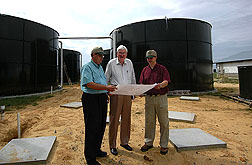More carbon credits per pig!
Slashing Greenhouse Gases From Hog Waste
In 2004, ARS soil scientists in South Carolina and colleagues introduced an innovative hog-waste management system that may greatly benefit swine producers and the environment alike.
Now these researchers have confirmed another environment-related benefit of this advanced technology: It dramatically reduces greenhouse gases emitted from hog operations.
Not only does this on-farm system—invented by soil scientists Matias Vanotti, Ariel Szögi, and Patrick Hunt at ARS’s Coastal Plains Soil, Water, and Plant Research Center in Florence—turn hog waste into material for soil amendments and fertilizers, it also removes almost all suspended solids from the wastewater. And in tests, its aerobic processes took out 95 percent of the polluted water’s total phosphorus and 99 percent of its ammonia. (See “Blue Lagoons on Pig Farms?” Agricultural Research, March 2005, p. 14.)
The patented technology is being called the “Super Soil System,” after Super Soil Systems USA, Inc., a North Carolina firm that implemented and is marketing it.
In the latest research—conducted at the 4,360-head finishing operation near Mount Olive, North Carolina, where initial system testing took place—the scientists found that replacing conventional anaerobic lagoon practices with the new technology reduced greenhouse-gas emissions by 99 percent!
“It cut emissions from 4,972 tons of carbon dioxide equivalents to 48 tons,” says Vanotti. “This indicates the system may have a role in fledgling CO2 trading markets, which allow farmers to earn money based on how much carbon dioxide and other greenhouse gases they can prevent from entering the atmosphere using alternative technologies. The way we see it, this system lets you squeeze more carbon credits per pig than the technology commonly used today does.”
Szögi adds that carbon credits can help alleviate installation costs associated with cleaner aerobic systems. “Our results show how these costs could be offset through greenhouse gas emission reductions,” he says.
Vanotti and Szögi used methods and monitoring data approved by 1992’s United Nations Framework Convention on Climate Change. They determined the amount of methane emitted from manure decomposing under anaerobic conditions as well as nitrous oxide emitted during storage and handling within each manure management system. For guidance, they consulted scientist Carlos Vives, who led a similar project at Agricola Super Limitada, Chile’s largest swine producer.
Full-scale demonstration of the system—the only on-farm technology certified in North Carolina to replace anaerobic lagoons—was made possible through agreements with North Carolina’s Attorney General’s office, Smithfield Foods, Inc., and Premium Standard Farms.
Vanotti says there’s widespread interest in this technology now and that full-scale implementation of a lower cost version of the system is also in the works.—By Luis Pons, Agricultural Research Service Information Staff.
This research is part of Manure and Byproduct Utilization, an ARS National Program (#206) described on the World Wide Web at www.nps.ars.usda.gov.
Matias B. Vanotti, Ariel A. Szögi, and Patrick G. Hunt are with the USDA-ARS Coastal Plains Soil, Water, and Plant Research Center, 2611 W. Lucas St., Florence, SC 29501-1241; phone (843) 669-5203, fax (843) 669-6970.
"Slashing Greenhouse Gases From Hog Waste" was published in the May/June 2007 issue of Agricultural Research magazine.







